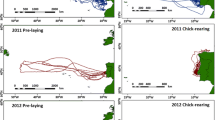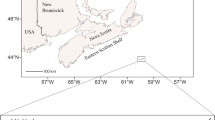Abstract
In variable environments, organisms are bound to track environmental changes if they are to survive. Most marine mammals and seabirds are colonial, central-place foragers with long-term breeding-site fidelity. When confronted with environmental change, such species are potentially constrained in their ability to respond to these changes. For example, if environmental conditions deteriorate within their limited foraging range, long-lived species favour adult survival and abandon their current breeding effort, which ultimately influences population dynamics. Should poor conditions persist over several seasons, breeding-site fidelity may force animals to continue breeding in low-quality habitats instead of emigrating towards more profitable grounds. We assessed the behavioural response of a site-faithful central-place forager, the Cape gannet Morus capensis, endemic to the Benguela upwelling system, to a rapid shift in the distribution and abundance of its preferred prey, small pelagic shoaling fish. We studied the distribution and the abundance of prey species, and the diet, foraging distribution, foraging effort, energy requirements, and breeding success of gannets at Malgas Island (South Africa) over four consecutive breeding seasons. Facing a rapid depletion of preferred food within their foraging range, Cape gannets initially increased their foraging effort in search of their natural prey. However, as pelagic fish became progressively scarcer, breeding birds resorted to scavenging readily available discards from a nearby demersal fishery. Their chicks cannot survive on such a diet, and during our 4-year study, numbers of breeding birds at the colony decreased by 40% and breeding success of the remaining birds was very low. Such behavioural inflexibility caused numbers of Cape gannets breeding in Namibia to crash by 95% following over-fishing of pelagic fish in the 1970s. In the context of rapid environmental changes, breeding-site fidelity of long-lived species may increase the risk of local or even global extinction, rendering these species particularly vulnerable to global change.



Similar content being viewed by others
References
Adams NJ, Navarro RA (2005) Foraging of a coastal seabird: flight patterns and movements of breeding Cape gannets Morus capensis. Afr J Mar Sci 27:239–248
Adams NJ, Abrams RW, Siegfried WR, Nagy KA, Kaplan IR (1991) Energy expenditure and food consumption by breeding Cape gannets Morus capensis. Mar Ecol Prog Ser 70:1–9
Bakun A (2006) Wasp-waist populations and marine ecosystem dynamics: navigating the “predator pit” topographies. Progr Oceanogr 68:271–288
Barange M, Hampton I, Roel BA (1999) Trends in the abundance and distribution of anchovy and sardine on the South African continental shelf in the 1990s, deduced from acoustic surveys. S Afr J Mar Sci 21:367–391
Batchelor AL, Ross GJB (1984) The diet and implications of dietary change of Cape gannets on Bird Island, Nelson Mandela Bay. Ostrich 55:45–63
Berruti A (1991) Comparison of the diet of breeding and non-breeding Cape Gannets. Ostrich 62:183–192
Berruti A, Underhill LG, Shelton PA, Moloney CL, Crawford RJM (1993) Seasonal and interannual variation in the diet of two colonies of the Cape gannet (Morus capensis) between 1977–1978 and 1989. Colonial Waterbirds 16:158–175
Berteaux D, Réale D, McAdam AG, Boutin S (2004) Keeping pace with fast climate change: can Arctic life count on evolution? Integr Comp Biol 44:140–151
Boulinier T, Danchin E (1997) The use of conspecific reproductive success for breeding patch selection in terrestrial migratory species. Evol Ecol 11:505–517
Burman J, Levin S (1974) The Saldanha bay story. Human and Rousseau, Cape Town
Coetzee JC, van der Lingen CD, Fairweather T, Hutchings L (2008) Has fishing pressure caused a major shift in the distribution of South African sardine? ICES J Mar Sci 65:1676–1688
Coulson JC (2002) Colonial breeding in seabirds. In: Schreiber EA, Burger J (eds) Biology of marine birds. CRC Press, Boca Raton, pp 87–113
Crawford RJM (1999) Seabird responses to long-term changes of prey resources off southern Africa. In: Adams NJ, Slotow RH (eds) Proceedings of the 22nd international ornithological congress, Durban. BirdLife South Africa, Johannesburg, pp 688–705
Crawford RJM (2005) Cape gannet. In: Hockey PAR, Dean WRJ, Ryan PG (eds) Roberts’ birds of Southern Africa, 7th edn. John Voelcker Bird Book Fund, Cape Town, pp 565–567
Crawford RJM (2007) Food, fishing and seabirds in the Benguela upwelling system. J Ornithol 148:S253–S260
Crawford RJM, Sabarros PS, Fairweather T, Underhill LG, Wolfaardt AC (2008) Implications for seabirds off South Africa of a long-term change in the distribution of sardines. Afr J Mar Sci 30:177–184
Doligez B, Cadet C, Danchin E, Boulinier T (2003) When to use public information for breeding habitat selection? The role of environmental predictability and density dependence. Anim Behav 66:973–988
Drent R, Daan S (1980) The prudent parent: energetic adjustment in avian breeding. Ardea 68:225–252
Enstipp MR, Daunt F, Wanless S, Humphreys EM, Hamer KC, Benvenuti S, Grémillet D (2006) Foraging energetics of North Sea birds confronted with fluctuating prey availability. In: Boyd IL, Wanless S, Camphuysen CJ (eds) Top predators in marine ecosystems. Cambridge University Press, Cambridge, pp 191–210
Erikstad KE, Fauchald P, Tveraa T, Steen H (1998) On the cost of reproduction in long-lived birds: the influence of environmental variability. Ecology 79:1781–1788
Fairweather TP, van der Lingen CD, Booth AJ, Drapeau L, van der Westhuizen JJ (2006a) Indicators of sustainable fishing for South African sardine Sardinops sagax and anchovy Engraulis encrasicolus. Afr J Mar Sci 28:661–680
Fairweather TP, Booth AJ, Sauer WHH, Leslie RW (2006b) Spatial description of hake-directed fishing activity off the west coast of South Africa. Afr J Mar Sci 28:13–24
Frederiksen M, Wanless S, Harris MP, Rothery P, Wilson LJ (2004) The role of industrial fisheries and oceanographic change in the decline of North Sea black-legged kittiwakes. J Appl Ecol 41:1129–1139
Furness RW, Tasker ML (2000) Seabird-fishery interactions: quantifying the sensitivity of seabirds to reductions in sandeel abundance, and identification of key areas for sensitive seabirds in the North Sea. Mar Ecol Prog Ser 202:253–264
Grémillet D, Argentin G, Schulte B, Culik BM (1998) Flexible foraging techniques in breeding Cormorants Phalacrocorax carbo and Shags Phalacrocorax aristotelis: benthic or pelagic feeding? Ibis 140:113–119
Grémillet D, Wilson RP, Storch GaryY (1999) Three dimension space utilization by a marine predator. Mar Ecol Prog Ser 183:263–273
Grémillet D, Dell’Omo G, Ryan PG, Peters G, Ropert-Coudert Y, Weeks S (2004) Offshore diplomacy, or how seabirds mitigate intra-specific competition: a case study based on GPS tracking of Cape gannets from neighbouring breeding sites. Mar Ecol Prog Ser 268:265–279
Grémillet D, Pichegru L, Siorat F, Georges JY (2006) Conservation implications of the apparent mismatch between population dynamics and foraging effort in Northern gannets from the English Channel. Mar Ecol Prog Ser 319:15–25
Grémillet D, Pichegru L, Kuntz G, Woakes AG, Wilkinson S, Crawford RJM, Ryan PG (2008) A junk food hypothesis for gannets feeding on fishery waste. Proc R Soc Lond B 18:1–9
Hunt GL, Mehlum F, Russell RW, Irons D, Beth Decker M, Becker PH (1999) Physical processes, prey abundance, and the foraging ecology of seabirds. In: Adams NJ, Slotow RH (eds) Proceedings of the 22nd international ornithological congress, Durban. Johannesburg, BirdLife South Africa, pp 2040–2056
IUCN (2006) 2006 IUCN red list of threatened species. http://www.iucnredlist.org/
Iverson SJ, Stirling I, Lang SLC (2006) Spatial and temporal variation in the diets of polar bears across the Canadian Arctic: indicators of changes in prey populations and environment. In: Boyd IL, Wanless S, Camphuysen CJ (eds) Top predators in marine ecosystems. Cambridge University Press, Cambridge, pp 98–117
Jackson JBC, Kirby MX, Berger WH, Bjorndal KA, Botsford LW, Bourque BJ, Bradbury RH, Cooke R, Erlandson J, Estes JA, Hughes TP, Kidwell S, Lange CB, Lenihan HS, Pandolfi JM, Peterson CH, Steneck RS, Tegner MJ, Warner RR (2001) Historical overfishing and the recent collapse of coastal ecosystems. Science 293:629–638
Klages NTW (1994) Dispersal and site fidelity of Cape gannets Morus capensis. Ostrich 65:218–224
Kokko H, Sutherland WJ (2001) Ecological traps in changing environments: ecological and evolutionary consequences of a behaviourally mediated Allee effect. Evol Ecol Res 3:537–551
Kristan WB (2003) The role of habitat selection behaviour in population dynamics: source-sink systems and ecological traps. Oikos 103:457–468
Matthiopoulos J, Harwood J, Thomas L (2005) Metapopulation consequences of site fidelity for colonially breeding mammals and birds. J Anim Ecol 74:716–727
Navarro RA (1991) Food addition and twinning experiments in the Cape gannet: effects on breeding success, chick growth and behaviour. Colonial Waterbirds 14:92–102
Orians GH, Pearson NE (1979) On the theory of the central place foraging. In: Horn DJ, Mitchell RD, Stairs GR (eds) Analysis of ecological systems. Ohio State University Press, Columbus, pp 154–177
Oro D, Cam E, Pradel R, Martínez-Abraín A (2004) Influence of food availability on demography and local population dynamics in a long-lived seabird. Proc R Soc Lond B 271:387–396
Parmesan C (2006) Ecological and evolutionary responses to recent climate change. Annu Rev Ecol Evol Syst 37:637–669
Pauly D, Christensen V, Guénette S, Pitcher TJ, Sumaila UR, Walters CJ, Watson R, Zeller D (2002) Towards sustainability in world fisheries. Nature 418:689–695
Peters RL, Lovejoy TE (1992) Global warming and biological diversity. Yale University Press, Cambridge
Pichegru L, Ryan P, van der Lingen C, Coetzee JC, Ropert-Coudert Y, Grémillet D (2007) Foraging behaviour and energetics of Cape gannets feeding on live prey and fishery waste in the Benguela upwelling system. Mar Ecol Prog Ser 350:127–136
Pinaud D, Cherel Y, Weimerskirch H (2005) Effect of environmental variability on habitat selection, diet, provisioning behaviour and chick growth in yellow-nosed albatrosses. Mar Ecol Prog Ser 298:295–304
Ridley M (1994) The Red-Queen. Penguin, London
Roy C, van der Lingen CD, Coetzee JC, Lutjeharms JRE (2007) Abrupt environmental shift associated with changes in the distribution of anchovy spawners in the southern Benguela. Afr J Mar Sci 29:309–319
Schmidt KA (2004) Site fidelity in temporally correlated environment enhances population persistence. Ecol Lett 7:176–184
Staverees L, Crawford RJM, Underhill LG (2008) Factors influencing the breeding success of Cape gannets Morus capensis at Malgas Island 2002–2003. Ostrich 79:67–72
van der Lingen CD, Shannon LJ, Cury P, Kreiner A, Moloney CL, Roux JP, Vaz-Velo F (2006) Resource and ecosystem variability, including regime shifts, the Benguela current system. In: Shannon V, Hempel G, Malanotte-Rizzoli P, Moloney C, Woods J (eds) Benguela: predicting a large marine ecosystem. large marine ecosystems 14. Elsevier, Amsterdam, pp 147–185
Wagner RH, Danchin E, Boulinier T, Helfenstein F (2000) Colonies as by-products of commodity selection. Behav Ecol 11:572–573
Weimerskirch H, Salamolard M, Sarrazin F, Jouventin P (1993) Foraging strategy of Wandering albatrosses through the breeding season: a study using satellite telemetry. Auk 110:325–342
Weimerskirch H, Mougey T, Hindermeyer X (1997) Foraging and provisioning strategies of black-browed albatrosses in relation to the requirements of the chick: natural variation and experimental study. Behav Ecol 8:635–643
Wilson RP, Pütz K, Peters G, Culik BM, Scolaro JA, Charassin JB, Ropert-Coudert Y (1997) Long-term attachement of transmitting and recording devices to penguins and other seabirds. Wildl Soc Bull 25:101–106
Acknowledgments
This study was funded by a studentship of the French Ministry of Research to LP, by the Centre National de la Recherche National via an ACI jeunes chercheuses et jeunes chercheurs to DG and by the DEPE-IPHC-CNRS. We thank South African National Parks for granting access to protected areas and the University of Cape Town for transport and logistic support. Marine and Coastal Management kindly provided logistical support in the field. We warmly thank P·H.R. Hockey, C. Gilbert and M. Enstipp and three anonymous referee for scientific input, and R. Navarro, J.P. Robin, L. Phiegeland, L. Drapeau, T. Fairweather, J. Coetzee, S. Lewis, G. Dell’Omo, S. Sari, J. Fort and R. Mullers for essential help in gathering and analysing the data.
Author information
Authors and Affiliations
Corresponding author
Additional information
Communicated by S. Garthe.
Rights and permissions
About this article
Cite this article
Pichegru, L., Ryan, P.G., Crawford, R.J.M. et al. Behavioural inertia places a top marine predator at risk from environmental change in the Benguela upwelling system. Mar Biol 157, 537–544 (2010). https://doi.org/10.1007/s00227-009-1339-2
Received:
Accepted:
Published:
Issue Date:
DOI: https://doi.org/10.1007/s00227-009-1339-2




